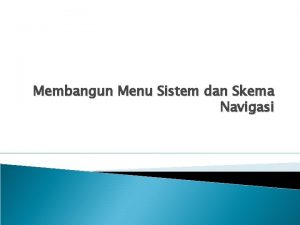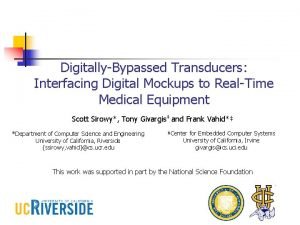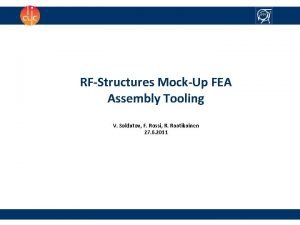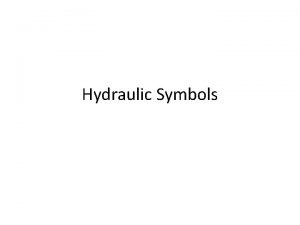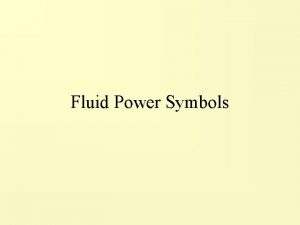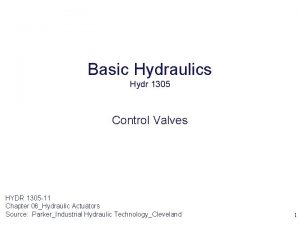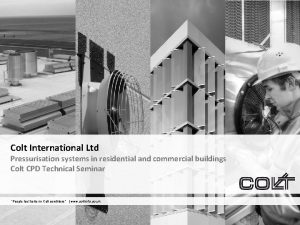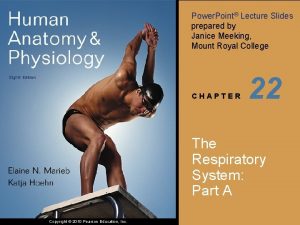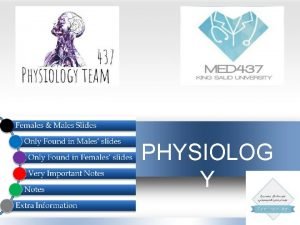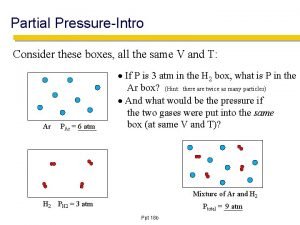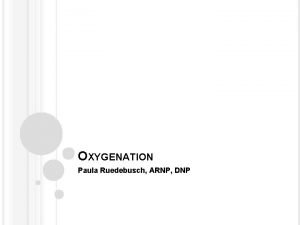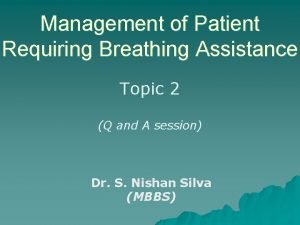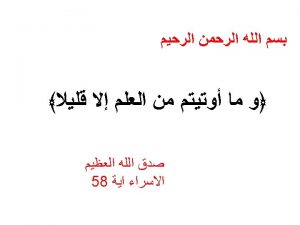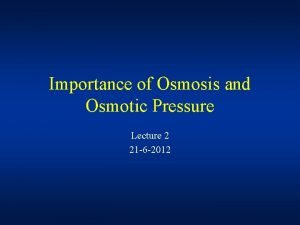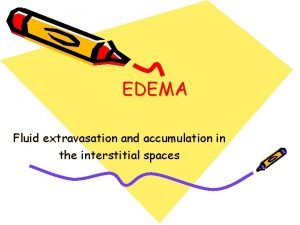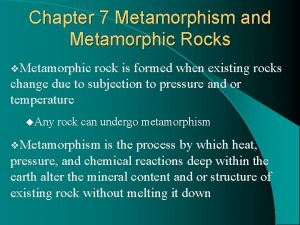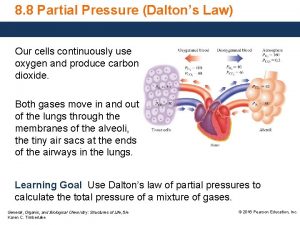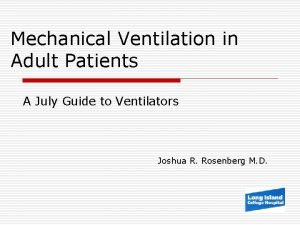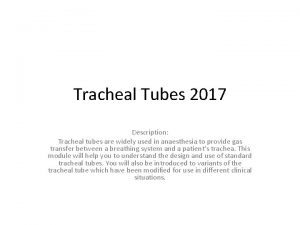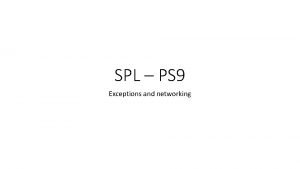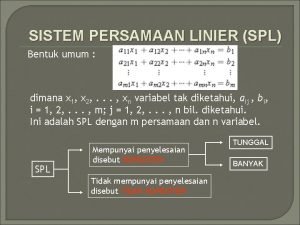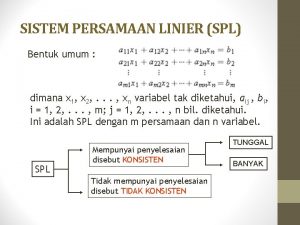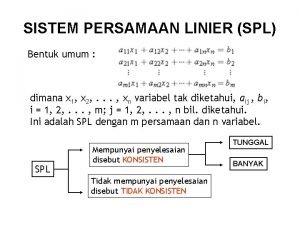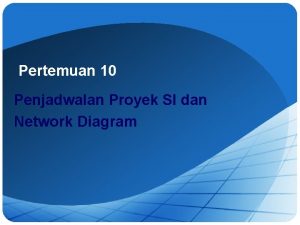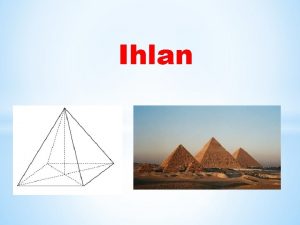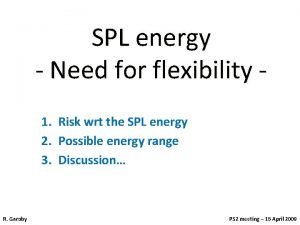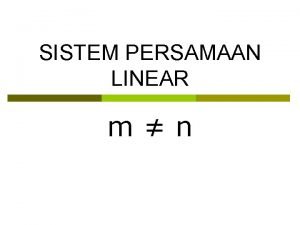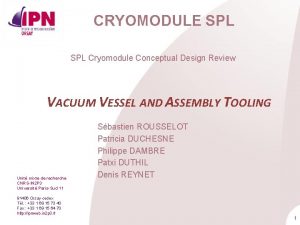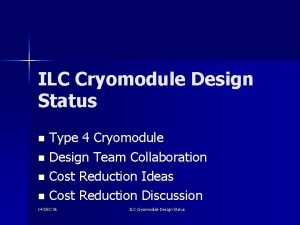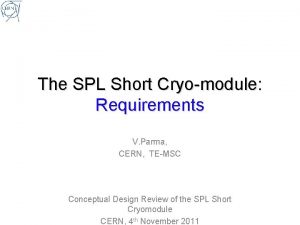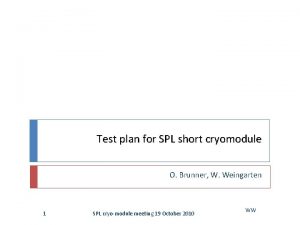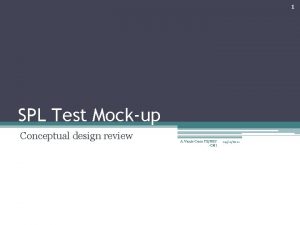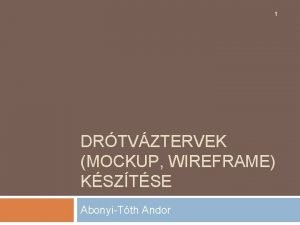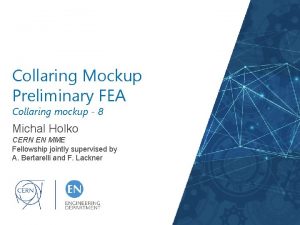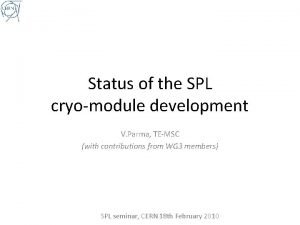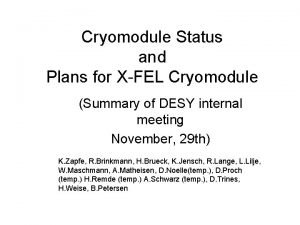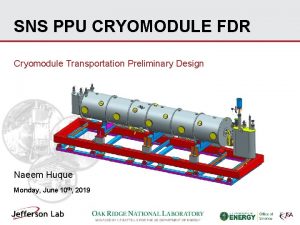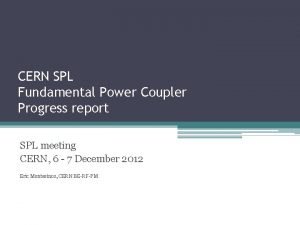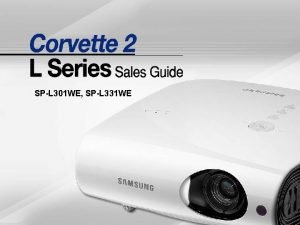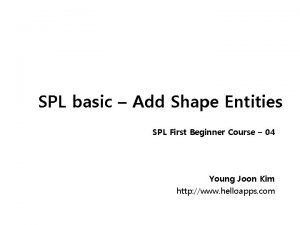SPL Short Cryomodule Design Mockup status pressure relief














































- Slides: 46

SPL Short Cryomodule Design Mock-up status, pressure relief devices and vacuum vessel mechanical calculations P. Azevedo (CERN-TE/MSC) SPL Internal Meeting, 07/12/2012

Summary 1. Overview of cavity supporting system 2. Status of supporting system mock-up 3. Pressure relief devices: introduction 4. Bursting discs for LHe 2 K volume 5. Vacuum vessel relief plate 6. Lower protection levels (for process and vacuum volumes) 7. Vacuum vessel mechanical calculations SPL Internal Meeting, 07/12/2012 2 / 34

1. Overview of cavity supporting system Supporting concept: Power coupler double tube as support • The power coupler double tube acts as vertical support and longitudinal positioner • The design is simplified • Better thermal performance - less heat conduction paths from room temperature SPL Internal Meeting, 07/12/2012 3 / 34

1. Overview of cavity supporting system Alignment tolerances TOLERANCES BUDGET FOR SPL CRYOMODULE Step Description 1_0 Cavities delivery to CERN 6_1 Assembling tuner outside clean room. Position tolerance of every cavity (3σ) ± 0. 4 mm ± 0. 1 mm (? ) Cumulative tolerances Sum of tolerances (mm) ± 0. 4 mm ± 1. 6 mm (? ) Cavity / He tank Cryomodule 1 Alignment string of He vessels under assembly girder ± 0. 1 mm 2 Load transfer to vac. vessel ± 0. 3 mm ± 0. 4 mm 3 Re-alignment via vessel flange screws adjustment ± 0. 2 mm 4 Mechanical mounting of top lid ± 0. 3 mm ± 0. 5 mm 5 Pump down ± 0. 1 mm ± 0. 6 mm 6 Transport & Handling ± 0. 1 mm (? ) ± 0. 7 mm (? ) 7 Cryostat @ cold (nominal operating T) ± 0. 1 mm (? ) ± 0. 8 mm (? ) 8 RF power on < ± 0. 1 mm < ± 0. 9 mm (? ) 9 CD/WU cycles ± 0. 1 mm (? ) < ± 1. 0 mm (? ) Total Arithmetic Quadratic 1. 6 0. 55 1 0. 42 2. 6 0. 69 1. 2 mm is an acceptable value for the cavities misalignment (3σ)* *Summary of the 4 th SPL SCM Working Group meeting held on 26/06/2012; R. Bonomi Cryomodule tolerances, V. Parma SPL Internal Meeting, 07/12/2012 4 / 34

1. Overview of cavity supporting system Vacuum vessel Double tube of the power coupler Interface with vacuum vessel SPL Internal Meeting, 07/12/2012 Inter-cavity support Helium tank 5 / 34

1. Overview of cavity supporting system Vacuum vessel / double tube interface and inter-cavity support Courtesy of P. Duthil / S. Rousselot (CNRS/IPNO) 241 mm He vessels flanges Sliding cylinder Deformable “triangle” SPL Internal Meeting, 07/12/2012 For more information on the design of these components and calculation notes concerning the supporting system, check the SPL workspace (references). . Spherical joint 6 / 34

2. Status of supporting system mock-up Introduction Filled with LN 2 Flow of GN 2 • Validate the supporting and alignment concept • Test critical components of unknown behaviour, the interface with vacuum vessel and the intercavity support, during assembly and cool-down • Validate thermal calculations – namely thermal model of actively cooled double • Learn about alignment survey methods and other measurements relevant for the SPL short cryomodule Mock-up developed by J-B. Deschamps, A. Vande Craen, R. Bonomi and P. Azevedo , in collaboration with different CERN groups. For more information, check the SLHi. PP 2 meeting presentation Mock-ups of the SPL cavity supporting system SPL Internal Meeting, 07/12/2012 7 / 34

2. Status of supporting system mock-up Instrumentation Scheme: Optical wire positioning monitor (stretched wire) will be installed in a second phase SPL Internal Meeting, 07/12/2012 8 / 34

2. Status of supporting system mock-up Courtesy of J-B. Deschamps • Design is finished – all components, cryogenic equipment and sensors have been defined / ordered • Vacuum vessel has been manufactured • Interfaces with vacuum vessel welded to double tubes (EBW) • Cold mass (LN 2 tanks) ready in a couple of weeks • Assembly and instrumentation process defined • Assembly and first alignment measurements: December 2012 / January 2013 • Cool down and first cold tests: first months of 2013 SPL Internal Meeting, 07/12/2012 9 / 34

2. Status of supporting system mock-up Courtesy of E. Rigutto SPL Internal Meeting, 07/12/2012 Courtesy of E. Rigutto 10 / 34

3. Pressure relief devices: Introduction Pressure / Temperature table: Line Description Pipe Size (ID min value) [mm] Z L X cavity/beam vacuum N. A. Cavity-helium cavity OD + vessel enclosure 10 Bi-phase pipe 100 Cool. Normal Cooldown / Normal Maximum operating down / warm-up T range operating pressure in operating temperat warm-up pressure temperat pressure case of MCI ure pressure [MPa] [T] [MPa] [K] [MPa] I. P. 10 -9 mbar (tbc) 0. 0031 2 2 N. A. 0. 13 @ 293 K N. A. 2 -293 293 -2 2 -293 0. 2 @ 2 K 0. 0031 2 0. 13 @ 293 K 0. 2 @ 2 K Y XB Cavity top connection Pumping line 80 0. 0031 2 0. 13 @ 293 K 0. 2 @ 2 K E E’ Thermal shield supply Thermal shield return 0. 15 @ 293 K; 0. 2 @ 2 K (tbc) 0. 15 @ 293 K 0. 2 @ 2 K (tbc) Test press ure [MPa] 0. 2 @ 2 K 0. 15 @ 293 K N. A. design pressure limited by cavity plastic deformation 0. 2 @ 2 K 0. 15 @ 293 K N. A. " Comment 15 1. 8 ~50 2 293 -50 50 -293 2 N. A. 2 2. 5 Heat intercept 15 1. 8 ~50 2 293 -50 50 -293 2 N. A. 2 2. 5 Return only W Cryostat vacuum vessel TBD I. P. 106 mbar 293 vacuum 293 C/C 1 Cavity filling 6 0. 1 4. 5 0. 1 293 -4. 5 -293 C 2 Coupler cooling 6 0. 1 4. 5 -293 0. 1 293 -4. 5 -293 C 3 Cavity top supply 10 0. 1 293 -4. 5 2 -293 SPL Internal Meeting, 07/12/2012 N. A. Design pressure 237 -293 O. P. 0. 15 @4. 5 K 0. 15 @ 4. 5 K I. P. 0. 15 @237 K O. P. 0. 1 @ 293 K; I. P. N. A. 0. 15 @237 K N. A. 0. 15 @ 293 K Liquid supply N. A. 0. 15 @ 293 K N. A. Gaseous supply N. A. 0. 15 @ 293 K N. A. Liquid supply V. Parma; SPL Pressure / Temperature Table 11 / 34

3. Pressure relief devices: Introduction Cryogenic Scheme: SPL Internal Meeting, 07/12/2012 O. Pirotte; SM 18 PID SPL Bunker 12 / 34

3. Pressure relief devices: Introduction Work in progress Risks overview: Hazard Leak to vacuum vessel Cause / Component Thermal cycles Mechanical loads Corrosion Welds Bellows Pipe Flanges Temporary (small) leak of air into vacuum volume Consequences Probability / Frequence Control measures related to pressure relief Pressure increase in vacuum vessel Loss of insulating vacuum (heat load) Low Vacuum vessel relief plate; Ps = 0. 5 barg (design pressure) Vaporization of condensed air High Vacuum vessel relief valve; Ps < 0. 5 barg Pressure increase in 2 K circuit Low 2 K circuit bursting discs; Ps = 0. 5 barg (design pressure) Static heat loads not compensated High 2 K circuit relief valve; Ps < 0. 5 barg Loss of insulating vacuum Loss of beam vacuum Pressure increase Overpressure in cryogenic supply Return pipe blocked Power failure SPL Internal Meeting, 07/12/2012 13 / 34

4. Bursting discs for LHe 2 K volume Heat input due to loss of beam vacuum: different tests, different results • LHe bath cooled Nb deflector: 3 mm thick; 30 mm opening; w = 18 k. W/m 2 • LEP cavity: 25 mm opening; 120 g/s; w = 10 k. W/m 2 80 mm opening; 1200 g/s, w = 40 k. W/m 2 • XFEL cryomodule: beam pipe opening; w = 23 k. W/m 2 (+/- 50 % uncertainty); w = 14. 2 k. W/m 2 (+/ - 10 % uncertainty) – different heat load estimation methods • Work in progress: these values are the result of tests carried out with different equipment and in different conditions. A proper understanding of the geometrical and physical parameters is required before estimations can be made for the SPL cryomodule (cavity geometry, venting diameter, relief devices set pressure, peak pressure) Safety aspects for LHe cryostats and LHe transport containers; Lehmann, Zahn; (1978) SPL Internal Meeting, 07/12/2012 Pressure protection against vacuum failures on the cryostats for LEP SC cavities; Cavallari et al; 1989 Experimental tests of fault conditions during the cryogenic operation of a XFEL prototype cryomodule; Boeckmann et al; 14 / 34

4. Bursting discs for LHe 2 K volume Heat input: loss of beam vacuum (no insulation) Estimate For the moment, the safety experts at CERN recommend 38 k. W / m 2 Table by C. Parente (DGS-SEE-XP) based on multiple sources; from calculation sheet developed by A. Henriques (DGS-SEE-XP) W. Lehmann Heat input determines mass flow: for 0. 4*Pcrit < Prelief < Pcrit SPL Internal Meeting, 07/12/2012 EN 13648 -3 For an overpressure of 10% (Prelief = 1. 55 bara): W/S (k. W/m 2) W (k. W) Qm (kg/s) 38 266 12 20 140 6. 3 15 / 34

4. Bursting discs for LHe 2 K volume Heat input: loss of insulating vacuum (with MLI) Estimate For comparison purposes, an estimation of the heat input and relief mass flow in the event of loss of insulation vacuum (not the dimensioning scenario) was carried out: For an overpressure of 10% (Prelief = 1. 55 bara): SPL Internal Meeting, 07/12/2012 W/S (k. W/m 2) W (k. W) Qm (kg/s) 6 48 2. 2 16 / 34

4. Bursting discs for LHe 2 K volume Relieving temperature and bursting disc(s) discharge coefficient • The saturation temperature at the relieving pressure is 4. 7 K. A value of 5 K was taken as relieving temperature, based on U. Wagner’s* initial estimates (conservative) • A discharge coefficient (α) of 0. 73 was taken – depending on final design, this value may be conservative EN ISO 4126 -6 *U. Wagner; Cryogenic scheme, pipes and valves dimensions; SPL Conceptual Design Review; 04/11/2011 SPL Internal Meeting, 07/12/2012 17 / 34

4. Bursting discs for LHe 2 K volume Results: Sizing of bursting discs w/S (kw/m 2) Work in progress – preliminary results No. Burst. Discs Dmin (mm) 1 93 2 65 1 127 2 90 EN ISO 4126 -6 20 38 • Formula units are not always consistent with the units presented • Kb is a correction factor for subcritical flow (function of the isentropic expansion coefficient k and pressure ratio) • C is a function of k Heat input value should be clarified before final design decisions Also affecting the design of the cryomodule: “The liquid container shall be protected against overpressure by a minimum of two relief devices in parallel, preferably of different types”* *Safety instruction IS 47: The use of cryogenics fluids ; CERN EDMS doc. 335812, by the Safety Comission SPL Internal Meeting, 07/12/2012 18 / 34

4. Bursting discs for LHe 2 K volume Pressure drop limits and cryomodule design w/S (kw/m 2) 20 38 No. Burst. ΔP (mbar)** Discs* Work in progress – preliminary results ΔP/Ps (%) 1 16 3 2 3 1 1 59 12 2 10 2 * For 2 bursting discs, these are considered to be placed on opposite ends of the bi-phase pipe. ** Pressure drop along the bi-phase pipe: no local pressure drops considered Courtesy of P. Duthil, S. Rousselot et al, CNRS / IPNO • The pressure drop along the bi-phase pipe is significant - the total pressure drop should be limited to 3% of Ps (EN 13648 -3) – 15 mbar • Local pressure drops have to be determined: since the dynamic/ velocity pressure of the discharged mass flow is 119 mbar, for an heat input of 20 k. W/m 2, we are limited to very small local pressure drop coefficients • An additional problem is the fact that only part of the bi-phase pipe will constitute a “free relief path” for a zero slope configuration (common LHe bath as opposed to the “roman fountain” solution for a positive slope) SPL Internal Meeting, 07/12/2012 19 / 34

5. Vacuum vessel relief plate Methodology – there is no “standard” method; 2 different methods were used: A) An orifice in the 2 K LHe circuit causes a discharge of LHe into the vacuum vessel (incompressible fluid). This mass flow, which depends on the orifice diameter, is the mass flow discharged by the relief plate, at subcritical flow and higher Trelief. • • Highly dependent upon orifice hole and Trelief Turns a highly transient phenomenon (LHe release into the vacuum) into a steady state process B) Complete rupture of the 2 K LHe enclosure: the vacuum vessel becomes a non-insulated cryostat. The heat load to the helium volume causes a discharge through the relief plate • The He density in the vacuum vessel is lower than the saturated vapour density at the relief pressure – mass flow calculation is not trivial SPL Internal Meeting, 07/12/2012 For both cases, the process volume relief devices (same set pressure) are ignored – conservative assumption 20 / 34

5. Vacuum vessel relief plate Work in progress – preliminary results Method A 1 st Step - incompressible flow through an orifice, into vacuum: 2 nd Step - compressible and subcritical flow through vacuum vessel relief plate: DRP (mm) vs Dorifice (mm) 500. 0 Tsat 20 K 70 K 400. 0 • A is the area of the orifice • Kd is the orifice coefficient of discharge; Kd=0. 62 (HSE recommendation) • P is the pressure in the process volume; P=1. 5 bar (design pressure) • Kd, RP is the coefficient of discharge of the relief plate; Kd=0. 73 was taken • Y is the expansion factor for the He vapour • ARP is the area of the relief plate orifice • PV is the relief pressure (1. 5 bara) • Pb is the back pressure (atmosphere) Which relief temperature? 300. 0 200. 0 Complete rupture of C 3 line bellows 100. 0 Complete rupture of bi-phase pipe bellows 0. 0 0 10 20 30 40 50 60 70 80 90 100 For the moment we can assume a 10 mm diameter as “reasonable”. This value corresponds to the complete rupture of the line C 3, and to a “reasonable size for an hypothetical orifice in the bi-phase pipe bellows SPL Internal Meeting, 07/12/2012 21 / 34

5. Vacuum vessel relief plate Method B Work in progress – preliminary results Due to large vacuum vessel volume, helium density is lower than density of saturated vapour at relief pressure. Two hypothesis: 1) Vaporization of LHe mass correspondent to cryomodule volume (identical to the 2 K LHe relief flow presented before) 2) Transient heat conduction to the Ghe mass filling the vacuum vessel; mass flow correspondent to density decrease due to temperature increase Calculation by R. Bonomi 1) 2) W (k. W) 184 59 Qm (kg/s) 8. 2 0. 2 "Tsat" 103 21 20 K 169 26 70 K 232 36 DRP (mm) Which relief temperature? SPL Internal Meeting, 07/12/2012 22 / 34

6. Lower protection level LHe 2 K circuit Work in progress – preliminary results • Event: power failure • Heat input: static heat loads – 70 W heat load to LHe bath* Ps (barg) 0. 3 Prel (bara) 1. 33 Kd 0. 5 Kdr 0. 45 w (W) 69. 7 Qm (g/s) 3. 0 Trel* (K) 5 Dmin (mm) 3. 0 ΔP/Ps (%) 0 *Tsat = 4. 5 K *R. Bonomi, SPL Short Cryomodule Heat loads; 3 rd SPL SCM WG Meeting, 22/5/2012 • Formula units are not always consistent with the units presented • Kb is a correction factor for subcritical flow (function of the isentropic expansion coefficient k and pressure ratio) • C is a function of k • Kd (Kdr=0. 9 Kd) is the coefficient of discharge EN ISO 4126 -1 • The mass flow and discharge area calculation follows the method used for the rupture discs (loss of beam vacuum) • Diameter is highly dependent on the coefficient of discharge (depends on the valve, and is usually lower for low set pressures) SPL Internal Meeting, 07/12/2012 23 / 34

6. Lower protection level Vacuum vessel • Event: temporary leak of air / air freezes immediately / leak is not detected / pressure rises during warm-up • Heat input calculation – appropriate method? • Relief plate (0. 5 barg) behaviour at relief valve set pressure (0. 3 barg, for instance)? • Possibility of using a specific relief plate design which can deal with both higher and lower protection levels (different relief pressures and discharge flows) – is being studied SPL Internal Meeting, 07/12/2012 24 / 34

7. Vacuum vessel mechanical calculations Introduction • Two-part vacuum vessel design carried out by CNRS/IPNO • Finished detailed design expected soon • Parallel calculations carried out at CERN 3 Re-alignment via vessel flange screws adjustment 4 Mechanical mounting of top lid 5 Pump down ± 0. 2 mm Possible until top lid is open (survey of single He vessel by laser tracker) ± 0. 3 mm ± 0. 5 mm Includes: adjustment of lid/vessel tolerances, sealing compression and tightening of bolts ± 0. 1 mm ± 0. 6 mm Depends on shape imperfections, stress relieving, etc. ± 0. 2 mm From Cryomodule tolerances; V. Parma SPL Internal Meeting, 07/12/2012 25 / 34

7. Vacuum vessel mechanical calculations String of cavities: deflection caused by induced displacements on interfaces with vacuum vessel May 2012 • A simplified model was used to evaluate the importance of the stability of the interfaces between power couplers double tubes and vacuum vessel for the alignment of the cavities • Linear and angular displacements were applied to the double tubes flanges and the effect on the alignment of the string of cavities was estimated SPL Internal Meeting, 07/12/2012 26 / 34

7. Vacuum vessel mechanical calculations String of cavities: deflection caused by induced displacements on interfaces with vacuum vessel May 2012 Results: maximum allowable interfaces displacements as a function of cavity alignment tolerance: Tolerance (mm) Maximum vertical displacement (mm) Maximum angular displacement (mrad)* +/- 0. 1 4. 0 0. 7 +/- 0. 2 8. 0 1. 5 +/- 0. 3 12. 0 2. 2 +/- 0. 4 16. 0 3. 0 +/- 0. 5 20. 0 3. 7 +/- 0. 6 24. 0 4. 4 +/- 0. 7 28. 0 5. 2 +/- 0. 8 32. 0 5. 9 +/- 0. 9 36. 0 6. 7 +/- 1. 0 40. 0 7. 4 * considering the results obtained from the induced displacements on the 5 th interface as valid Low angle propagation and high relative bending stiffness of inter-cavity support suggest that significant values of displacement (vertical and angular) induced on the interfaces to the vacuum vessel may compromise structural integrity of the helium vessels – although results were obtained considering a fixed connection between double tubes and vacuum vessel and an infinitely rigid vacuum vessel SPL Internal Meeting, 07/12/2012 27 / 34

7. Vacuum vessel mechanical calculations Stability of interfaces with double tubes during pump down • The effect of the vacuum load on the stability of the interfaces with the double tubes was studied in parallel with CNRS/IPNO (P. Duschesne) • Similar, but not identical, models, contact properties and boundary conditions were used by CERN and CNRS/IPNO September 2012 (work presented in WG meeting 6) Courtesy of P. Duchesne et al ; CNRS / IPNO SPL Internal Meeting, 07/12/2012 28 / 34

7. Vacuum vessel mechanical calculations Stability of interfaces with double tubes during pump down September 2012 (work presented in WG meeting 6) Results – vertical displacement (uz) of interfaces with double tubes for vacuum load: uz [mm] 0. 2 0. 15 0. 1 CNRS / Nonlinear contacts 0. 05 CERN / Linear contacts 0 0 -0. 05 SPL Internal Meeting, 07/12/2012 2 4 6 CERN / Linear contacts / Simple interfaces Interface 29 / 34

7. Vacuum vessel mechanical calculations Mounting of the lid: effect of flat flanges shape imperfections • The effect of the shape imperfections of the two vacuum vessel connection flanges on the stability of the vacuum vessel during its closing was studied in parallel with CNRS/IPNO (P. Duchesne) • Different assumptions and calculations by CERN and CNRS/IPNO • In both cases, the closing of the vessel was not “simulated” – assumptions were made and the results are not expected to be representative • A planarity tolerance of 0. 6 mm for each flange was considered Courtesy of P. Duchesne et al; CNRS / IPNO SPL Internal Meeting, 07/12/2012 30 / 34

7. Vacuum vessel mechanical calculations Mounting of the lid: effect of flat flanges shape imperfections; CNRS/IPNO approach 1. 2 mm rattrapé par 1 vis CAS 1 Exemple de défaut de planéité 1. 2 mm Modèle: géométrie parfaite chargement du défaut =1. 2 mm 242 mm CAS 2 1. 2 mm rattrapé par 2 vis contigües Déplacement (mm) suivant Z : 242 mm CAS 3 Liaisons boulonnées uniquement sur les extrémités de l’enceinte CAS 4 1. 2 mm gap rattrapé par 2 vis au centre (gauche et droit) 7000 mm Liaisons boulonnées uniquement sur la moitié de l’enceinte Configuration Bearing 1 Bearing 2 Bearing 3 Bearing 4 Bearing 5 Cas 1 0. 0005 -0. 0036 0. 0021 -0. 0001 0. 0002 Cas 2 0. 0026 -0. 0167 0. 0062 -0. 0003 0. 0011 Cas 3 -0. 045 0. 036 0. 063 0. 036 -0. 045 Cas 4 0. 024 -0. 016 -0. 029 -0. 018 0. 024 1. 2 mm gap rattrapé par 4 vis à l’extrémité Elément poutre Connecteur rigide 3500 mm SPL Internal Meeting, 07/12/2012 Many assumptions were made: results are not expected to be representative or definitive From Test cryomodule: Modélisation d’un défaut géométrique; P. Duchesne et al 31 / 34

7. Vacuum vessel mechanical calculations Mounting of the lid: effect of flat flanges shape imperfections; CERN approach • Displacements applied to bottom flange taking into account the relative stiffness of top and bottom part of vessel • Entire vessel is modelled and a perfect contact between flanges is used - this should be conservative because a more rigid connection should impose a larger flange deformation, and consequently a larger deformation of the whole bottom part of the vessel Load case 1 1. 2 mm SPL Internal Meeting, 07/12/2012 Load case 2 32 / 34

7. Vacuum vessel mechanical calculations Mounting of the lid: effect of flat flanges shape imperfections; CERN approach Deformed shape: Load case 1 Load case 2 Maximum interface displacement as a function of flange displacement magnitude: Load Case Sign uz (mm) d=0. 42 mm (LC 1) uz (mm) d=0. 45 mm (LC 2) 1 + 0. 13 - 1 - 0. 12 - 2 + - 0. 08 2 - - 0. 08 SPL Internal Meeting, 07/12/2012 Many assumptions were made: results are not expected to be representative or definitive 33 / 34

References • SPL Workspace: https: //espace. cern. ch/spl-cryomodule • V. Parma; “Cryomodule tolerances” • R. Bonomi; “Summary of the 4 th SPL SCM Working Group meeting held on 26/06/2012” • P. Azevedo et al; “Mock-ups of the SPL cavity supporting system”; SLHi. PP 2 meeting; 03/05/2012 • EN ISO 4126: Safety devices for protection against excessive pressure (parts 1, 6, and 7) • EN 13648: Cryogenic vessels – Safety devices for protection against excessive pressure (part 3) • EN 13458: Cryogenic vessels – Static vacuum-insulated vessels (part 2) • U. Wagner; “Cryogenic scheme, pipes and valves dimensions”; SPL Conceptual Design Review; 04/11/2011 • R. van Weelderen; “Open Cryogenic Action Items”; 4 th SPL SC WG meeting; 26/06/2012, updated 04/07/2012 • R. Bonomi; “SPL Short Cryomodule Heat loads”; 3 rd SPL SCM WG Meeting, 22/5/2012 • O. Pirotte; “SM 18 PID SPL Bunker” • V. Parma; “SPL Pressure / Temperature Table” • A. Henriques; "Safety Accessory Calculation Tool for Cryogenic Vessels“ • Lehmann and Zahn; “Safety aspects for LHe cryostats and LHe transport containers” (1978) • Cavallari et al; “Pressure protection against vacuum failures on the cryostats for LEP SC cavities” (1989) • Boeckmann et al; “Experimental tests of fault conditions during the cryogenic operation of a XFEL prototype cryomodule” • CERN Safety Comission; “Safety instruction IS 47: The use of cryogenics fluids”; CERN EDMS doc. 335812 • P. Azevedo; “String of cavities – deflection caused by induced displacements on interfaces with vacuum vessel” • P. Azevedo; “FE calculations of the vacuum vessel of the SPL Short Cryomodule”; 6 th SPL SC WG meeting; 18/09/2012 • P. Duchesne, P. Duthil and S. Rousselot; “ Test cryomodule: Mechanical studies“; 6 th SPL SC WG meeting; 18/09/2012 • P. Duchesne, P. Duthil and S. Rousselot; “ Test cryomodule: Modélisation d’un défaut géométrique“ SPL Internal Meeting, 07/12/2012 34 / 34

Thank you for your attention

Spare slides

Heat loads table - TOTAL Subassembly Double-walled tube Cold-warm transition Cavity Type Source Destination cd rad RF DWT bath cv DWT gas - cd WF TS - cd TS CM 0. 8 x 2 = 1. 6 rad WF + wall CM 1. 0 x 2 = 2. 0 rad WF TS rad VV TS rad TS CM 1. 6 CM - (1) - (2) 68. 7 (1) 5. 7 (2) RF cavity TOT for SCM (W) 2 K 13 (1) x 5 = 65 0. 5 (3) x 4 + 0. 1 x 1 = 2. 1 0. 1 (2) x 5 = 0. 5 4. 5 K 50 K - - 22 (4) x 4 + 13 x 1 = 101 - (1) Static heat loads (1) RF off, cool off (2) RF off, cool on Dynamic heat loads (3) RF on, cool on (4) RF on, cool off 60 (2) x 5 = 300 60 (3) x 5 = 300 - (4) - - 23. 0 x 2 = 46. 0 0. 8 x 2 = 1. 6 - - 1. 0 x 2 = 2. 0 - - 0. 2 x 2 = 0. 4 - - 45 1. 6 - - 20. 0 (3) x 4 = 80. 0 20. 0 (4) x 4 = 80. 0 - - 87. 3 (3) 186. 2 (4) - 300 (2) 300 (3) - 91. 4 (R. Bonomi)

Expansion factor

Critical / subcritical flow

EN 16648 -3 – Pressure drop

Helium volume inside SPL cryomodule Volume of 2 K circuit (l) 4 cavities 64 l 1 phase separator 5 l 1 x line 47. 1 l l=6000; d=100 4 Y lines 2. 5 l l=100; d=100 total 318. 3 l

Heat input table by C. Parente From A. Henriques; "Safety Accessory Calculation Tool for Cryogenic Vessels"

Local pressure drop coefficients Examples of Minor loss coefficients for different components common in air duct distribution systems: (http: //www. engineeringtoolbox. com/minor-loss-air-ducts-fittings-d_208. html) Minor Loss Coefficient - ξ - Component or Fitting 90 o bend, sharp 1. 3 90 o bend, with vanes 0. 7 90 o bend, rounded radius/diameter duct <1 0. 5 90 o bend, rounded radius/diameter duct >1 0. 25 45 o bend, sharp 0. 5 45 o bend, rounded radius/diameter duct <1 0. 2 45 o bend, rounded radius/diameter duct >1 0. 05 T, flow to branch (applied to velocity in branch) 0. 3

String of cavities: deflection caused by induced displacements on interfaces with vacuum vessel; results Load case 1 z 1 zb 1α 1αb 2 z 2 zb 2α 2αb 3 z 3 zb 3α 3αb 4 z 4 zb 4α 4αb 5 z 5 zb 5α 5αb Cavity 1 angle (mrad) 0. 37 0. 02 0. 41 0. 03 0. 04 0. 00 0. 00 disp. (mm) 0. 08 -0. 03 0. 47 -0. 47 0. 04 -0. 05 0. 00 0. 01 -0. 01 0. 00 Cavity 2 angle (mrad) 0. 00 0. 01 0. 37 0. 02 0. 41 0. 03 0. 04 0. 00 disp. (mm) 0. 00 0. 08 -0. 03 0. 47 -0. 47 0. 04 -0. 05 0. 00 Cavity 3 angle (mrad) 0. 00 0. 01 0. 37 0. 02 0. 41 0. 04 0. 03 disp. (mm) 0. 00 0. 08 -0. 03 0. 47 -0. 47 0. 04 -0. 03 Cavity 4 angle (mrad) 0. 00 0. 01 0. 37 0. 04 0. 37 0. 24 disp. (mm) 0. 00 0. 08 -0. 05 0. 42 -0. 42 0. 27 -0. 27

String of cavities: deflection caused by induced displacements on interfaces with vacuum vessel; stress results Example (load case 2α ): Von Mises stress (MPa); model and mesh not detailed enough – this is not a stress analysis

Mounting of the lid: effect of flat flanges shape imperfections; different calculation Opening of 5 mm between flanges (warped vessel) June 2012 For this first step load (0. 6 MPa), the displacements of the interfaces are quite small. For comparison, the pressure value correspondent to 60 k. N/m (reference value for 30% of O-ring deformation) is around 0. 8 MPa. P (MPa) ux, max uy, max uz, max αmax 0. 6 0. 03 0. 04 0. 50 1. 2 0. 08 0. 03 0. 02 0. 54 1. 8 0. 13 0. 04 0. 01 0. 78 2. 4 0. 18 0. 04 0. 02 1. 23 3 0. 23 0. 04 1. 86 Displacements of interfaces with double tube (maximum absolute values)
 Long and short
Long and short Functional mockup interface
Functional mockup interface Mockup login page
Mockup login page Mockup address
Mockup address Membangun menu sistem dan skema navigasi
Membangun menu sistem dan skema navigasi Prinsip mockup
Prinsip mockup Visio shape data fixed list
Visio shape data fixed list Mockup assembly
Mockup assembly Segregator mockup
Segregator mockup Unidirectional motor symbol
Unidirectional motor symbol Hydraulic oil pressure symbol
Hydraulic oil pressure symbol Pressure relief valve symbol
Pressure relief valve symbol Pressure relief damper for staircase
Pressure relief damper for staircase Wiberg patella
Wiberg patella Pressure support vs pressure control
Pressure support vs pressure control Continuous bedside pressure mapping
Continuous bedside pressure mapping Intrapulmonary pressure vs intrapleural pressure
Intrapulmonary pressure vs intrapleural pressure Oncotic pressure
Oncotic pressure Partial pressure
Partial pressure Intrapleural pressure vs intrapulmonary pressure
Intrapleural pressure vs intrapulmonary pressure Regional metamorphism
Regional metamorphism Pressure support vs pressure control
Pressure support vs pressure control Dynamic pressure formula
Dynamic pressure formula Oncotic vs hydrostatic pressure
Oncotic vs hydrostatic pressure Oncotic pressure vs hydrostatic pressure
Oncotic pressure vs hydrostatic pressure Osmosis blood pressure
Osmosis blood pressure Oncotic pressure vs hydrostatic pressure
Oncotic pressure vs hydrostatic pressure Metamorphism
Metamorphism Blood pressure regulation
Blood pressure regulation How to find partial pressure
How to find partial pressure Pressure support vs pressure control
Pressure support vs pressure control High pressure and low pressure
High pressure and low pressure High pressure and low pressure
High pressure and low pressure Ihlan obsah
Ihlan obsah Spl exceptions
Spl exceptions Bentuk umum spl
Bentuk umum spl Bentuk umum spl
Bentuk umum spl Bentuk umum spl
Bentuk umum spl Bentuk umum sistem persamaan linear tiga variabel
Bentuk umum sistem persamaan linear tiga variabel Povrch hranolu s lichoběžníkovou podstavou
Povrch hranolu s lichoběžníkovou podstavou Spl proyek adalah
Spl proyek adalah Výška jehlanu vzorec
Výška jehlanu vzorec Patboky ihlan
Patboky ihlan Spl energy
Spl energy Spl konsisten
Spl konsisten Lu dekomposisi
Lu dekomposisi Bočná hrana ihlana
Bočná hrana ihlana




